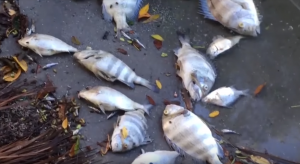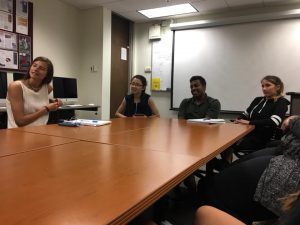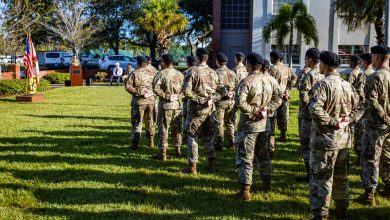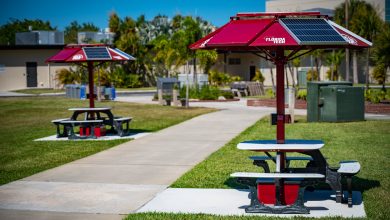Communication Majors Create Moving Documentary About Indian River Lagoon
by Lindsay Isaac
The most biologically diverse estuary in North America is dying—and Florida Tech students are trying to save it.

That became the premise of the 13-minute capstone documentary produced by seniors in Florida Tech’s communication program this semester, Dr. Johnson’s Lab.
I was the director of Dr. Johnson’s Lab, which traces the story of Florida Tech graduate students and their efforts to save the deteriorating Indian River Lagoon.
When I shuffled into Crawford 611 at the beginning of Spring 2018 with the 12 other Florida Tech communication students enrolled in Senior Design, I had no idea the course would take us onto the lagoon and into the lab of Florida Tech professor Dr. Kevin Johnson.
But, I’m so thankful that it did.
SENIOR DESIGN, DR. JOHNSON, DANI, NAYAN AND XIAO
Senior Design is a semester-long course that requires the development and presentation of a real-world team project—and for communication seniors, this often means making a documentary.

So, that’s exactly what our class decided to do.
We threw around story ideas, but one student who’s a Melbourne-native, Ken McDonald, was adamant about focusing our documentary on the Indian River Lagoon — a struggling estuary that is right in Florida Tech’s back yard.
After some deliberation, we decided to pursue the idea, but we still didn’t have much of a story angle.
It wasn’t until over a month into the semester that we decided we wanted to tell the story of Florida Tech students working on Indian River Lagoon-related projects.

But none of us had any knowledge of ocean science at Florida Tech.
So, by my professor’s recommendation, I emailed Dr. Johnson (chair of ocean sciences at Florida Tech) to ask if he could send me a list of students working on these projects.
Instead, Dr. Johnson said I could come to his lab meeting and pitch the documentary to his students.
That’s where I first met Dani Juzwick (a Pittsburgh-native who loves to fish) and Nayan Mallick (a newly-wed from Bangladesh), two of the main characters in our documentary — and of course, Dr. Johnson.
And a few weeks after that, I met Xiao Ma (an only child from China), who would become the third main character in our documentary.
FOOTAGE, INTERVIEWS, AND OTHER ADVENTURES
Our class only met every Tuesday and Thursday for an hour and 15 minutes, so we spent hours outside of the classroom gathering footage, conducting interviews and getting to know Nayan, Dani and Xiao.

We followed along on a pontoon boat and on a Boston Whaler as they collected sediment samples from Crane Creek and Turkey Creek as part of their efforts to study the effects of dredging on specific organisms in the lagoon.
We spent hours with them in the lab, Link 152, as they sifted through the sediment looking for, identifying and counting microscopic life.
And despite a lot of late nights, tons of moving pieces and some hiccups with PremierPro, we did it—we created Dr. Johnson’s Lab.
I’m so proud of my team for bringing the documentary to life — and I’m so thankful to have had the opportunity to work with Dr. Johnson & his students.
LESSONS LEARNED
Before Senior Design, I knew nothing about documentary-making and very little about the Indian River Lagoon.

But, I’ve learned so much through the course.
One of the most important understandings I’ve come to is that this 156-mile estuary, which stretches along the state’s Atlantic Coast, truly needs our help — and it’s going to take a community to save it.
The lagoon’s sandy seabed, once alive with blue crabs and other organisms, has become clogged and coated by black, mayonnaise-esque muck that virtually nothing can live in.
Some of the hundreds of species living within the Indian River Lagoon are being choked out by the polluted sediment.

Massive algal blooms have killed thousands of acres of lush sea grass in the lagoon.
Fish kills and the deaths of other organisms are common.
A number of factors have contributed to the degradation of the once thriving Indian River Lagoon.
But Dr. Johnson and his students believe there is hope — and with collective action, I agree.
Watch the documentary here:





